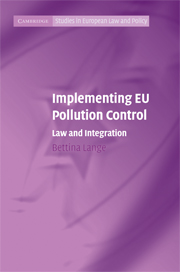Book contents
- Frontmatter
- Contents
- Series editors’ preface
- Acknowledgements
- Update on the IPPC Directive
- Abbreviations
- 1 Introduction
- 2 Traditional perspectives on the role of law in EU integration
- 3 Critical perspectives on the role of law in EU integration
- 4 What is EU ‘law in action’?
- 5 Talking interests – generating procedure: How political discourse constructs key aspects of BAT determinations in BREFs
- 6 Variation in open and closed BAT norms
- 7 What does it cost? Economic discourse in the determination of ‘the best available techniques’ under the IPPC directive
- 8 Does ‘law’ integrate? Licensing German and English coke ovens under the IPPC Directive
- 9 Conclusion
- Appendix: Methodology
- Bibliography
- Index
2 - Traditional perspectives on the role of law in EU integration
Published online by Cambridge University Press: 07 August 2009
- Frontmatter
- Contents
- Series editors’ preface
- Acknowledgements
- Update on the IPPC Directive
- Abbreviations
- 1 Introduction
- 2 Traditional perspectives on the role of law in EU integration
- 3 Critical perspectives on the role of law in EU integration
- 4 What is EU ‘law in action’?
- 5 Talking interests – generating procedure: How political discourse constructs key aspects of BAT determinations in BREFs
- 6 Variation in open and closed BAT norms
- 7 What does it cost? Economic discourse in the determination of ‘the best available techniques’ under the IPPC directive
- 8 Does ‘law’ integrate? Licensing German and English coke ovens under the IPPC Directive
- 9 Conclusion
- Appendix: Methodology
- Bibliography
- Index
Summary
Introduction
This chapter discusses a number of contributions which form what I call ‘traditional perspectives’ on law and European integration. The literature in this area is rich and multifaceted. The label ‘traditional perspectives’ does not fully capture all its subtleties and variety. Hence, my construction of ‘traditional perspectives’ in this chapter is a heuristic device. By drawing out key ideas which inform these traditional perspectives on law in EU integration, I seek to clarify how ‘critical perspectives’ (discussed in chapter 3) and the book's analysis of the empirical case studies (chapters 5, 6, 7 and 8) challenge some of the tenets of traditional approaches.
The traditional perspectives seek to analyse relationships between law and integration by asking ‘what role does law play in EU integration?’ But this assumes, rather than questions, what law is. Law is regarded as the independent, pre-given variable, while integration is the dependent variable. Moreover, the traditional perspectives draw on a conception of law which is derived from the internal descriptions of the legal field which the formal EU and national legal systems themselves generate. Hence such perspectives emphasise formal and instrumental dimensions of law. Law is also taken to be relatively autonomous and thus to have a significant integrating force which is distinct and separate from the social, political and economic dynamics promoting integration. Traditional perspectives focus on the behaviour of official legal actors when analysing the implementation of EU and national law.
- Type
- Chapter
- Information
- Implementing EU Pollution ControlLaw and Integration, pp. 28 - 54Publisher: Cambridge University PressPrint publication year: 2008

